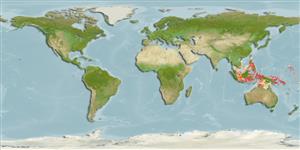>
Gobiiformes (Gobies) >
Gobiidae (Gobies) > Gobiinae
Etymology: Eviota: No etymology given, suggested by Christopher Scharpt: from Latin 'eu' for 'true' and 'iota' for anything very small, in combination 'truly very small' referring to it as being the smallest vertebrate at the time it has benn described by Jenkins (thus, making the suggestion by Scharpt plausible; jewettae: Named for Susan L. Jewett, who previously recognized this species as undescribed from specimens taken by the Smithsonian Philippine Expedition in 1978.
Eponymy: Susan Lee Jewett (formerly Susan J Karnella) (d: 1945) is an American ichthyologist who was Collections Manager, Division of Fishes, Smithsonian Institution. [...] (Ref. 128868), visit book page.
Environment: milieu / climate zone / depth range / distribution range
Ecologia
marinhas associadas(os) a recifes; intervalo de profundidade 7 - 33 m (Ref. 92345). Tropical
Western Pacific: known from Palau (only from Helen Reef, the southern-most of the South West Islands), Philippine Islands, Papua New Guinea and Raja Ampat, Indonesia.
Tamanho / Peso / Idade
Maturity: Lm ? range ? - ? cm
Max length : 1.2 cm SL macho/indeterminado; (Ref. 92345); 1.2 cm SL (female)
Descrição suscinta
Chaves de identificação | Morfologia | Morfometria
Espinhos dorsais (total) : 6; Raios dorsais (total) : 8; Espinhos anais: 1; Raios anais : 8. This species is distinguished from congeners by the following set of characters: cephalic sensory-pore system lacking all pores 98% of the time; dorsal/anal fin-ray formula 8/8; pectoral-fin rays 15-16, ventralmost two rays unbranched with at least 2 (but up to 4) lower rays branched at tips above this, remainder of rays unbranched; 4th pelvic-fin ray bifurcated with each branch about 60% of total length of the ray; unbranched 5th pelvic-fin ray 13-20% of 4th; non-filamentous dorsal-fin spines, tubular anterior nares short, less than ½ pupil diameter in length; when alive, body is translucent and crossed by five broad orange to red bands (Ref. 82345).
Ciclo de vida ou comportamento de acasalamento
Maturidade | Reprodução | Desova | Ovos | Fecundidade | Larvas
Greenfield, D.W. and R. Winterbottom, 2012. Two new dwarfgobies from the Southwestern Pacific Ocean (Teleostei: Gobiidae: Eviota). Zootaxa 3572:33-42. (Ref. 92345)
Status na Lista Vermelha da UICN (Ref. 130435: Version 2024-1)
Ameaça para os humanos
Harmless
Uso pelos humanos
Ferramentas
Relatórios especiais
Baixar XML
Fontes da internet
Estimates based on models
Preferred temperature (Ref.
123201): 28 - 29.1, mean 28.6 °C (based on 62 cells).
Índice de diversidade filogenética (Ref.
82804): PD
50 = 0.5000 [Uniqueness, from 0.5 = low to 2.0 = high].
Bayesian length-weight: a=0.01023 (0.00477 - 0.02194), b=3.01 (2.83 - 3.19), in cm total length, based on LWR estimates for this (Sub)family-body shape (Ref.
93245).
Nível Trófico (Ref.
69278): 3.0 ±0.3 se; based on size and trophs of closest relatives
Fishing Vulnerability (Ref.
59153): Low vulnerability (10 of 100).
